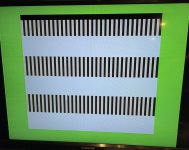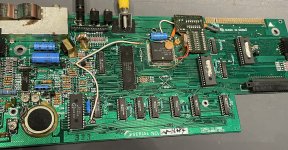ianoid
Experienced Member
Hello all,
I have a 2068 that shows these bars. I figured I'd replace any bad RAM and socket it. Unfortunately I pulled up a few traces but I put (yellow) bodge wires best I could between the RAM legs with the bad traces. After confirming all the RAM is good, what is the next step to troubleshoot the bar screen? Also, should most of the RAM be in line? It seems like 4 of the chips have mostly continuity between the pins and two have fewer pins in continuity. I looked at what I thought was a schematic (TS 2000 board) and it seemed like most of the pins should be continuous between all 6 RAM chips. The bar screen looks more or less the same after getting all working RAM installed.
I also recapped the board.
Besides the RAM, what would be the next move to getting it to work?
I am using a spec matched modern PS instead of the original one I have for it.
I have a 2068 that shows these bars. I figured I'd replace any bad RAM and socket it. Unfortunately I pulled up a few traces but I put (yellow) bodge wires best I could between the RAM legs with the bad traces. After confirming all the RAM is good, what is the next step to troubleshoot the bar screen? Also, should most of the RAM be in line? It seems like 4 of the chips have mostly continuity between the pins and two have fewer pins in continuity. I looked at what I thought was a schematic (TS 2000 board) and it seemed like most of the pins should be continuous between all 6 RAM chips. The bar screen looks more or less the same after getting all working RAM installed.
I also recapped the board.
Besides the RAM, what would be the next move to getting it to work?
I am using a spec matched modern PS instead of the original one I have for it.



